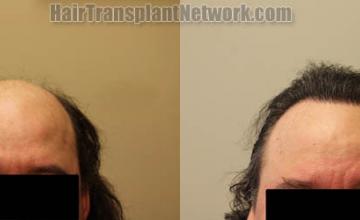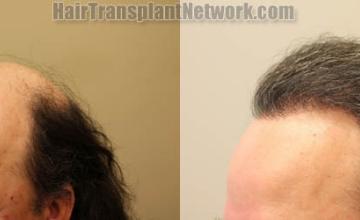Procedure detail
This is a bit of a different case than I usually present but this is a man who had very extensive hair loss, Norwood 6, and who wanted to restore some natural looking hair to his head. If I recall correctly, he had previously worn a full hair system but no longer wanted to do so. However, I informed him that we could not give him high density and cover all of his head as I was certain he did not have enough accessible donor hair to fill in all of these areas from frontal hairline to vertex, particularly if he wanted a lower hairline, as the balded vertex area was very wide and would have required a very large number of grafts. I informed him that (1) we could try to fill in everything at low density (which I did not think would look good as it would be spreading the paint far too thin, so to speak), (2) we could fill in the frontal scalp with high density (and possibly a lower hairline) and leave the rest (requiring him to use a hair system for the remainder of the bald area as it looks odd to have a thick frontal hairline and bald vertex), or (3) we could do something called a frontal forelock pattern for the frontal scalp where he may or may not decide to wear a hair system to cover the remaining bald area.
Some of you may be aware of this pattern but for the sake of others, a frontal forelock pattern consists of a thicker frontal forelock area to provide density. As we go laterally from the frontal forelock, the density diminishes before gradually increasing as it approaches the temples and temporal humps. This pattern emulates a pattern of hair loss that exists in nature so it still looks natural while not requiring large numbers of grafts. In his case, he liked this idea as he was willing to consider wearing a hair system in the vertex area to keep that area covered if he wanted.
Just under one year ago, we did his frontal forelock transplant and used a total of 694 single hair grafts, 1583 double hair grafts, and 524 three hair grafts, for a total of 2801 grafts. We considered lowering his hairline more but it would have required a minimum of 1000 grafts to do so to any significant degree and we decided not to use/spend any more precious grafts to do this as he might want to use any additional grafts to go more posteriorly in the future.
He came in last week and has had quite a significant improvement. He is very happy with the result!
Although this is not the typical case we do, it shows how sometimes a patient may not go for high density throughout and/or may not go for a low hairline as there are many factors that need to be considered. In some cases where there is insufficient supply to meet the demand, we sometimes have to selectively choose areas where lower density will still look natural.
If you analyze the photos, you can appreciate the difference in density between the more densely transplanted frontal forelock and the thinner areas lateral to the forelock. I think that when using this pattern, it is important to dense pack the forelock to make that area look thick. In my opinion, it really does not look as good if the forelock looks thin. In addition, we also had to thicken up his temporal humps a bit as they were showing some definite weakness, particularly posteriorly.
Hair Restoration Forum
Bald class

Norwood stage 6
The balding areas at the temples join with the balding area at the vertex. The band of hair across the top of the head is gone or sparse.



